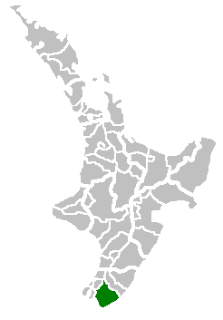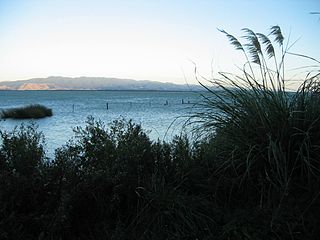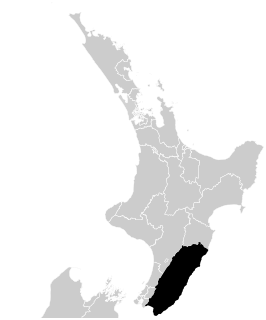
The North Island, also officially named Te Ika-a-Māui, is one of the two main islands of New Zealand, separated from the larger but much less populous South Island by Cook Strait. The island's area is 113,729 square kilometres (43,911 sq mi), making it the world's 14th-largest island. It has a population of 3,749,200.

The South Wairarapa District is an area at the south-east tip of the North Island of New Zealand governed by the South Wairarapa District Council. The district comprises the southernmost part of the Wairarapa, and is part of the Wellington Region.

The Remutaka Range, is the southern-most range of a mountain chain in the lower North Island of New Zealand. The chain continues into the Tararua, then Ruahine Ranges, running parallel with the east coast between Wellington and East Cape.

Palliser Bay is at the southern end of the North Island of New Zealand, to the southeast of Wellington. It runs for 40 kilometres along the Cook Strait coast from Turakirae Head at the southern end of the Rimutaka Ranges to Cape Palliser, the North Island's southernmost point.

Cape Palliser is a promontory on the southern coast of New Zealand's North Island and is the southernmost point of the North Island; it is in fact considerably farther south than Nelson or Blenheim in the South Island.

The Ruamahanga River runs through the southeastern North Island of New Zealand.

The Aorangi Range is a mountain range on the North Island of New Zealand. It is located in the Wairarapa region, extending more than 20 kilometres north from Cape Palliser, and is the southernmost mountain range on the island. The greater portion of these mountains are covered in native forest which is protected and set aside for public recreational use as part of the Aorangi Forest Park.
The Awhea River is a river of New Zealand. It is in the Wairarapa, close to the North Island's southernmost point, and flows south for 24 kilometres (15 mi) from rough hill country south of Martinborough to reach the Pacific 20 kilometres (12 mi) to the east of Cape Palliser.
The Huangarua River is a river of the southern North Island of New Zealand. Rising in the foothills of the Aorangi Range it flows north to join the Ruakokoputuna River to the south of Martinborough.
The Mangawharariki River is a river of the Manawatu-Wanganui Region of New Zealand's North Island. It flows northwest from the Ruahine Range to meet the Rangitikei River at Mangaweka.
The Oterei River is a river of the southern Wairarapa, in the Wellington Region of New Zealand's North Island. It flows initially northwest before turning south to reach Cook Strait 30 kilometres (19 mi) northeast of Cape Palliser.
The Rerewhakaaitu River is a river of the Wellington Region of New Zealand's North Island. It flows southeast from its sources in rough hill country southeast of Martinborough, reaching the Pacific Ocean 40 kilometres (25 mi) northeast of Cape Palliser.

The Tauherenikau River is a river of the Wellington Region of New Zealand's North Island. It flows initially southeast from its sources on the slopes of Mount Hector before turning southwest to run down a long valley in the Tararua Range. From the end of the valley it again turns southeast, flowing past the town of Featherston before reaching the northern shore of Lake Wairarapa.
The Waingawa River is a river of the Wellington Region of New Zealand's North Island. A major tributary of the Ruamahanga River, it flows generally southeast from its origins close to The Mitre, the highest peak of the Tararua Range. The Waingawa flows through the western suburbs of the city of Masterton and reaches the Ruamahanga 10 kilometres (6 mi) southeast of Carterton.
The Wainuiora River is a river of the Wellington Region of New Zealand's North Island. It is an upper tributary of the Wainuioru River.
The Wainuioru River is a river of the Wellington Region of New Zealand's North Island. A major tributary of the Pahaoa River, it follows a twisting generally southwestward course from its origins 25 kilometres east of Masterton, reaching the Pahaoa 20 kilometres (12 mi) southeast of Martinborough.

The Waiohine River is a river of the Wellington Region of New Zealand's North Island. It flows generally south from its origins in the Tararua Range south-east of Levin, turning south-east once it reaches the plains to the north of Lake Wairarapa. From here, the river flows through many channels and irrigation features, with some of its waters reaching the lake but most flowing into the Ruamahanga River south-east of Greytown.
The Whawanui River is a river of the Wellington Region of New Zealand's North Island. It flows south from the Aorangi Range to reach Cook Strait 10 kilometres (6 mi) northeast of Cape Palliser. It is one of the southernmost rivers in the North Island.
The Makara River is a tributary of the Huangarua River, part of the Ruamahanga River system in New Zealand. It flows north from the Aorangi Range, reaching the Huangarua to the south of Martinborough.











